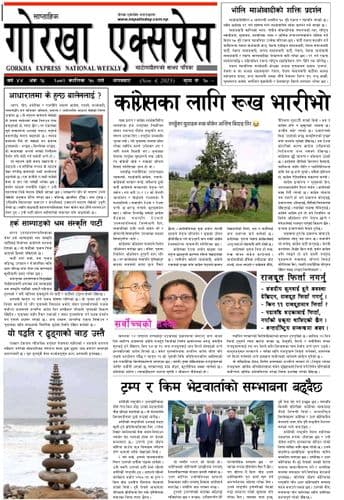
From Araniko repaired acupuncture figure, to Gorkha's tribute knife and much more... The Araniko Project
Oct 5
Compared to the pre-COVID era, since China opened up in 2023, entering landmark sites like The Forbidden City or National Museum could become a tedious task. With only 40,000 visitors permitted every day, tickets will be sold out very quickly given its vast and soaring internal tourism market.
A couple of weeks ago, we as the co-founders of The Araniko Project were fortunate enough to be able to enter the National Museum of China, Beijing. We expected that the diplomatic gifts given by Nepali leaders to China would be on display. The significance of diplomatic gifts given by Nepali Monarchs and leaders to China is, in a way, a display of how Nepal conducted its foreign policy. While that opportunity wasn’t available to us, yet, there are lots of interesting displays that showcase Nepal’s significance in China.
In this blog, we provide some of the important, yet little-discussed exchanges between Nepal and China. There are still lots of interesting facts to uncover in the National Museum of China on Nepal, some of which include resolving the boundary issue between Nepal - China by 1960, and so on.
1: Iron knife Gift to Qing Dynasty in 1785
In the display is this written as an Iron Knife gift to the Qing Dynasty in 1785 A.D. The Araniko Project has previously done a translation of the Gorkha dynasty’s tributes to the Qing Dynasty which was sent during the time of Rana Bahadur Shah¹. Knives accounted for a significant portion of Gorkha’s tribute as they considered knives as their destiny. Three years later after receiving the gift, the first Gorkha-Qing war would start.
2: Nepal’s gift of Spinach to China
While documented written archives from the Tang Dynasty (618 to 906 A.D) prove that spinach was gifted by Nepal, according to this table, spinach was unearthed as early as the Western Han dynasty (202 BCE-8CE).
3: Bronze Figure Model for Acupuncture and Moxibustion
Bronze Figure Model for Acupuncture and Mosxibustion repaired by Araniko
During the Tiansheng Era (1023-1032) in the Northern Song Dynasty, a medical official named Wang Weiyi made two bronze figures marked with meridians and acupoints and wrote the Illustrated Manual about Acupoints Indicated on Recently Cast Bronze Figures. In the Imperial Medical Academy’s exams, such figures were coated with beeswax and filled with water for students to identify the right acupoints.
Connection to Nepal: This figure was repaired by Araniko during the Yuan Dynasty (1271-1368). Documented in «??·????» Yuan History: Biography of Araniko)
In the second year of the Zhongtong era of the Yuan dynasty (1261), Kublai Khan asked Araniko, "What skills do you have?" Araniko replied, "I use my heart as my teacher and have some knowledge of painting, sculpture, and casting." The emperor ordered the bronze acupuncture figure from the Ming Tang to be shown to him and said, "This was presented by the envoy Wang Ji during the Song dynasty. It has been damaged over time, and no one has been able to restore it. Can you make it new again?" Araniko replied, "Although I have never done this before, I would like to try." By the second year of the Zhiyuan era (1265), the new figure was completed, with all the veins and channels depicted. The metalworkers marveled at its divine craftsmanship, and none could help but feel ashamed in comparison. The Nepalese craftsman Araniko completed its restoration, finishing the work in 1265.
4: The Commemorative shield
The commemorative shield by Nepal and other countries
Museum Description: Commemorative silver shield bestowed upon Zhou Enlai by 11 Asian and European countries with embassies in China ( Vietnam, Cambodia, India, Burma, Pakistan, Pakistan, the Soviet Union, Poland, Hungary, Afghanistan, Nepal, and Ceylon (Sri Lanka) in 1957.
Nepali Ambassador to China, Daman SJB Rana signed on the shield.
5: The White Dagoba of Miaoying Temple
Miaoying Temple White Dagoba
The White Dagoba is located in Miaoying Temple in Fuchengmen, Beijing. It is the oldest and largest Tibetan Buddhist pagoda in Beijing. It was built by Araniko (1244-1306 AD) in the Country of Ní-bó-luo (present-day Nepal).
Note: Different dynasties have had different names for Nepal, during the Qing dynasty, it was Ní-bó-luo-guó????, while, People’s Republic of China calls it Ní-bó-er???.
Interested about learning more about The White Dagoba? Read some of our works:
(Part1/3) Collection of rare old photos and introductions of Báita Temple
(Part1/3) Collection of rare old photos and introductions of Báita Temple
Aneka Rebecca Rajbhandari
6: BOAO Forum for Asia
In February 2001, the founding conference of the Boao Forum for Asia was held in Hainan, China. The picture shows the leaders from various countries attending the meeting on the stage.
King Birendra (front first from left), Chinese President Jiang Zemin ( front middle). Previously, the BOAO forum of Nepal was represented by the monarch and have been regular participant of the forum since 2001. However, in 2021 Nepal did not even get the invitation to attend the forum - an example of Nepal’s failure to maintain its position on this international platform.
@ The Araniko Project


